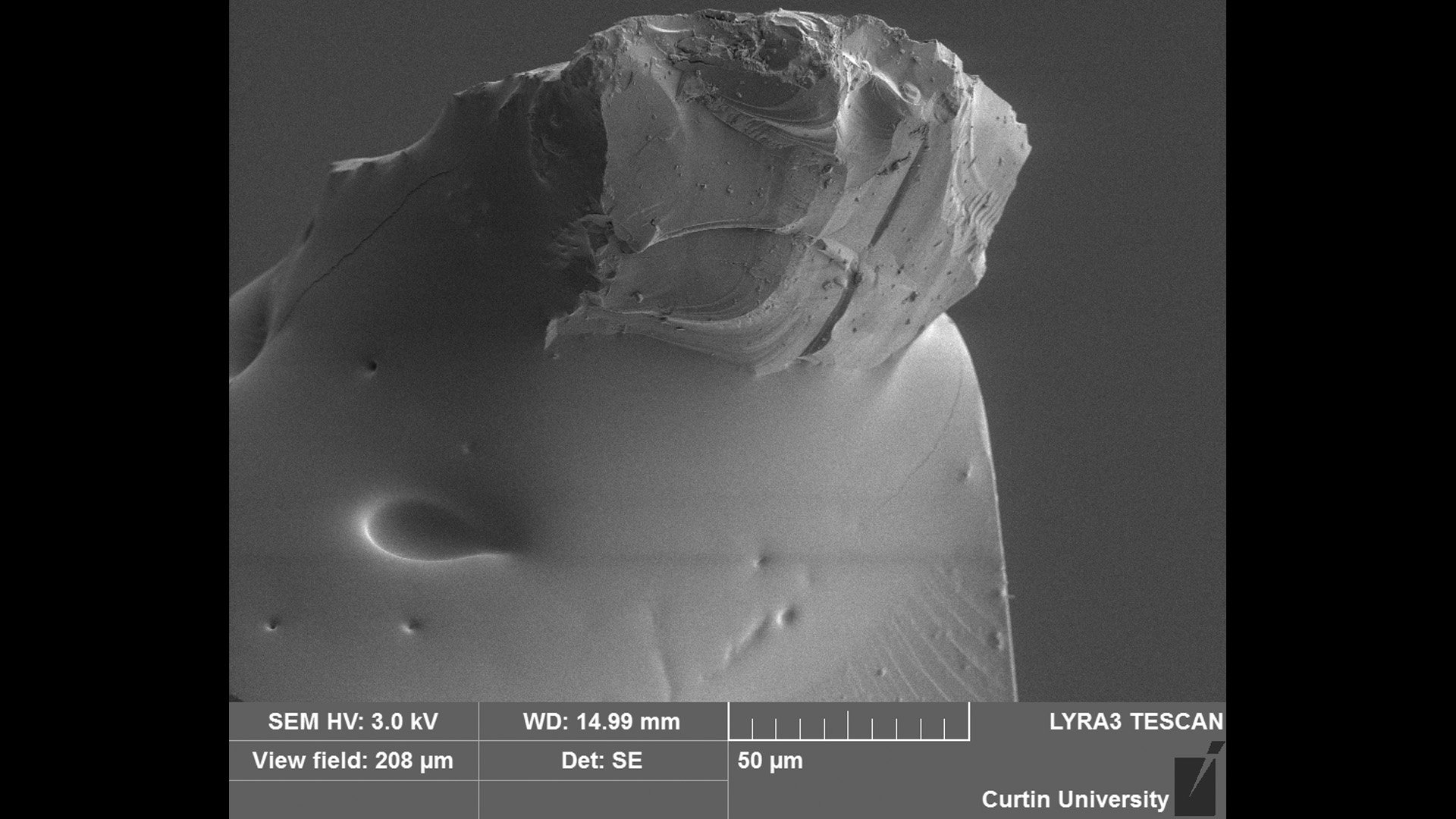Earth's earliest water may have come from solar wind and space rocks

Samples from asteroid Itokawa collected by a Japanese space probe suggest that Earth's water may have been created by the sun.
This water may have rained on the fledgling Earth in the form of dust grains produced by the interaction of the solar wind, the stream of charged particles emanating from the sun, with various bodies in the solar system, a new study suggests.
"The solar winds are streams of mostly hydrogen and helium ions which flow constantly from the sun out into space," Luke Daly, a planetary scientist at the University of Glasgow in the U.K., and a lead author of the new paper said in a statement. "When those hydrogen ions hit an airless surface like an asteroid or a spaceborne dust particle, they penetrate a few tens of nanometers [one inch has 24.5 million nanometers] below the surface, where they can affect the chemical composition of the rock."
Related: Touchdown! Incredible Photos Show 2nd Asteroid Landing by Japan's Hayabusa2
Over time, this space weathering effect of the hydrogen ions can eject enough oxygen atoms from materials in the rock to create water, which remains locked within the asteroid, Daly added.
This mechanism may be the missing link explaining the abundance and chemical composition of water on Earth that has long baffled scientists. Earth's surface is 70% covered with water. That's much more than any other planet in the solar system. But none of the existing theories can fully explain all of it. A dominant view suggests that asteroids rich in carbon, which pummeled the young Earth some 4.6 billion years ago, delivered this water to the planet.
But detailed chemical analysis of meteorites known as carbonaceous chondrites, which are chunks of these carbon-rich asteroids, revealed that the water locked inside them doesn't quite match the chemical fingerprint of Earth's water.
Breaking space news, the latest updates on rocket launches, skywatching events and more!
This discrepancy in what scientists call isotopic composition led researchers to believe that there must be at least one additional source of our planet's life-giving liquid. Isotopes are forms of chemical elements that differ just by the number of uncharged neutrons they contain. The carbonaceous chondrites tend to have water that contains more deuterium, a form of hydrogen with one neutron, while Earth's hydrogen is mostly a lighter form called protium that has no neutrons.
In search of the additional source of Earth's water, the team of researchers analyzed the composition of a rocky type of asteroid rich in silicon oxide using a novel technique called the atom probe tomography. Using this technique, the researchers measured the atomic structure of these grains one atom at a time to detect individual water molecules. The samples analyzed in this study came from the asteroid Itokawa, famously visited by the Japanese probe Hayabusa, which delivered tiny pieces of this space rock to Earth in 2010.

"[Our technique] lets us take an incredibly detailed look inside the first 50 nanometers [one inch has 24.5 million nanometers] or so of the surface of dust grains on Itokawa, which orbits the sun in 18-month cycles," Phil Bland, the director of the Space Science and Technology Center at Curtin University in Australia and co-author of the new study, said in the statement. "It allowed us to see that this fragment of space-weathered rim contained enough water that, if we scaled it up, would amount to about 20 liters [4.4 gallons] for every cubic meter [35 cubic feet] of rock."
The particles produced in the interaction of Itokawa's dust and the solar wind had more of the lighter form of hydrogen than the carbon-rich asteroids, Bland added.
"That strongly suggests that fine-grained dust, buffeted by the solar wind and drawn into the forming Earth billions of years ago, could be the source of the missing reservoir of the planet's water," Bland said.
But the research isn't just about Earth. The findings also suggest that water might be locked in the surface rocks of many space bodies, including the moon and asteroids, the researchers said in the statement. If so, this could be good news for future human exploration in deep space, as necessary supplies might be easier to find than scientists fear.
"One of the problems of future human space exploration is how astronauts will find enough water to keep them alive and accomplish their tasks without carrying it with them on their journey," Hope Ishii, a geophysicist at the University of Hawai'i at Mānoa and also a co-author of the paper said in the statement.
"We think it's reasonable to assume that the same space weathering process which created the water on Itokawa will have occurred to one degree or another on many airless worlds," she added. "That could mean that space explorers may well be able to process fresh supplies of water straight from the dust on the planet's surface."
The research is described in a paper published Monday (Nov. 29) in the journal Nature Astronomy.
Follow Tereza Pultarova on Twitter @TerezaPultarova. Follow us on Twitter @Spacedotcom and on Facebook.

Tereza is a London-based science and technology journalist, aspiring fiction writer and amateur gymnast. She worked as a reporter at the Engineering and Technology magazine, freelanced for a range of publications including Live Science, Space.com, Professional Engineering, Via Satellite and Space News and served as a maternity cover science editor at the European Space Agency.
